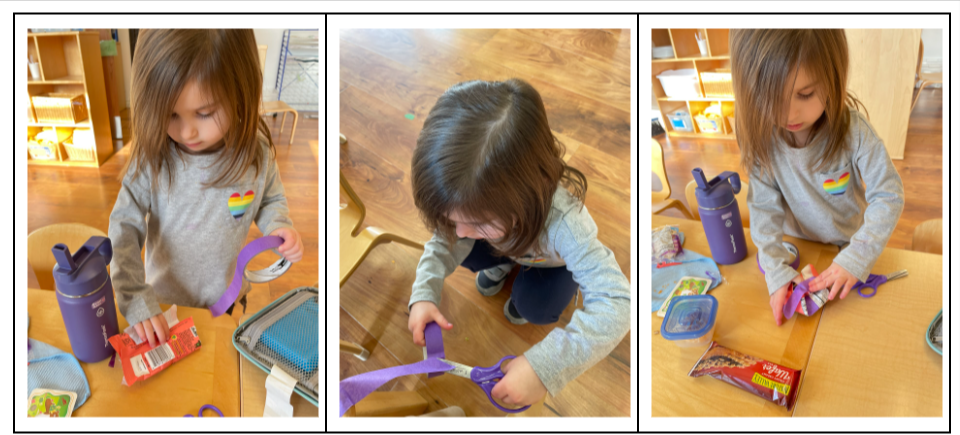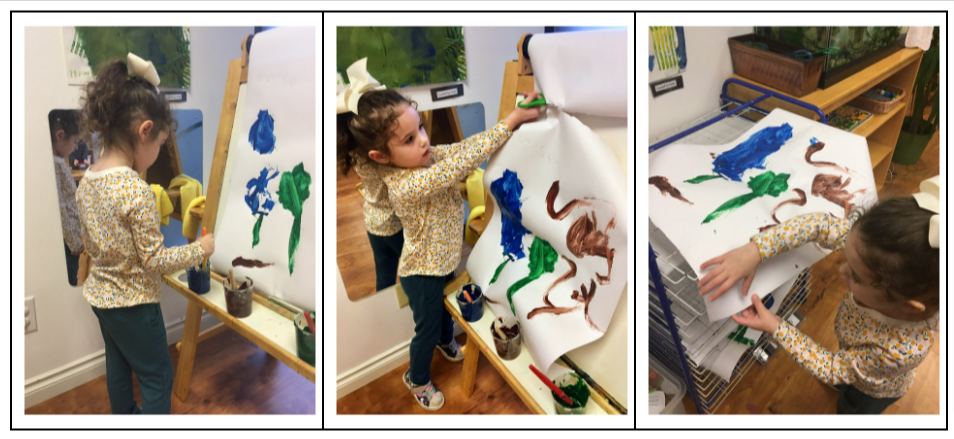Promoting Self-help Skills at the Gan Garrett Jewish Preschool
When we think about self-help skills and preschool children, some of the first things that come to mind are putting toys away and putting shoes on. At the Gan Garrett Jewish preschool, we definitely encourage and model these tasks. However, there are many more situations that occur naturally each day that allow our preschool children to develop skills in this important area. But before talking about that, I’d like to address why self-help skill development is important even for very young children.
Isn’t it just quicker, easier and cleaner if I do tasks for young children? Tasks such as pouring water for a drink, sweeping sand off the floor or cleaning up a big glue spill take a lot of time, and sometimes it can get even messier before it is finished. So why do we teach and encourage toddlers and preschool children at the Gan to learn how to do these for themselves?
When we teach children to do things for themselves, we empower them to be strong, capable and independent; they gain confidence and mastery in their abilities and in themselves. They gain important skills that are building blocks for learning that will take place the rest of their lives. They learn to problem solve, and, over time, make choices that they can carry out independently, without having to wait for a Morah to get or do everything for them. Children also learn to be responsible for the choices they make.
Here are a few scenarios at the Gan where children learn to meet their own needs and meet the expectations of the preschool.

On his first day of preschool, Norman watched a peer get a cup, get the jug of water, pour themselves a drink, and put the jug back. Norman got up, did the exact same thing, sat down and drank his water. And he’s been meeting this need by himself ever since.

Evie has learned (with help as needed, at first) to get a pair of “lunch scissors” and tape, and to seal her snack bags closed by herself.

We all spill, including the Morahs. (I recently spilled cups of grape juice and modeled how to clean up and move on). We remind children that it’s okay, and part of life. We teach the children how to take care of their own spills. Over time, the children learn where to find the brooms and towels, how to clean up and carry on with their day.

Some of the activities have multiple steps, and we teach them by directly walking and talking children through the steps. Lilah chose to use the dry watercolor set, so we showed her how to put the container, brush and a piece of paper on the table, and to then pick up the jar, add some water to it, and set it on her table so that she could paint. After she painted, we talked her through putting her activity away. Here, she is pouring out the water as part of her clean up. Over time, even young children remember the steps, and can manage to set up and clean up their own activities. Children gain confidence when they realize they can make choices and carry them out without having to ask for or wait for help.

Eloise wrote her name, painted, cut her painting off the roll, and set it on the drying rack herself. As children gain competency, they realize that they are strong and capable and can accomplish many things on their own. They become more confident, and we frequently see them try new activities, attempt to do something they have not yet been successful in, or problem solve situations on their own. In the final sets of pictures, you will see young children, who have had many opportunities to learn how to do things for themselves and accomplish some challenging tasks and feats on their own.

In the time Kenya has been in preschool, she has learned to use scissors during many different activities and tasks. She has learned how to cut her own tape as needed, where to find (and ultimately put things away) all the different supplies on her own. She has gained confidence in her abilities, and in making choices, so, when we studied different animals, and invited the children to make some kind of animal for themselves, Kenya walked over to the art materials, made her choices, sat down, and created her own costume. The only thing she needed any help for was taping the tail part around her waist. She has developed the skills she needs during daily activities and tasks.


Hugo has had multiple opportunities to develop his scissors and tape skills during his time at the Gan preschool, by opening sandwich bags, sealing them up, and making lots of different projects. When he wanted to make a fan, the only part he needed a little help for was in how to make the folds go backwards and forwards. After being shown, he did the folding himself. He then got scissors and tape, in order to wrap it around the end so the fan wouldn’t come apart. He has the skills and confidence he needs to complete many different projects, and he never hesitates to try something new. Or ask for help when needed.

In the first picture, Brexton is sitting on the tallest wooden train in our playground. He got up there entirely on his own. What you can’t see in this picture are the attempts he made over a year. Nor can you see all the individual tasks he learned to do by himself in the classroom over that same period of time. You can, however, see by his smile, the confidence and pride he feels at accomplishing this very challenging task by himself.
In the second picture, you see the end result of children working together to make the “campfire” by themselves. Together, with no help from the Morahs, they hauled all the tires over, and lifted them, one on top of another. Look at the size of the tires, and at the size of the children. These are children who are strong and capable, and willing to take on tasks, because they have had numerous opportunities to learn, and master, many, many tasks on their own.
As with all aspects of learning and development of skills, everything is a process. Sometimes it's a back-and-forth process. All children develop at their own pace. At the Gan Garrett Jewish Preschool, we have an age/stage range from 2 1/2 years to 5+. As Morahs, through close observation, one-to-one time with each child and participation in group activities, we become aware of where each student is in their learning and development in all domain areas, and we work to encourage and facilitate their progress into next steps. You have seen pictures of children of varying ages doing all sorts of tasks; Morahs provide modeling, verbal, hand-over-hand, and one-on-one assistance to all children as needed. And then we back off, as children gain mastery of skills. And confidence. And the desire to try new, and other challenging tasks, games, and activities. These self-help skills, and the confidence that comes from knowing they are strong and capable, will be an asset to children as they move on to kindergarten and other areas in life.


